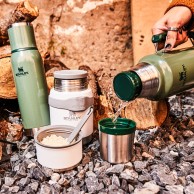Do your metal water bottles contain lead?
Food safety of the water bottles we use on our bike is in question after the detection of lead, a highly toxic metal, in the metal bottles from the Stanley brand that many choose as an alternative to the usual plastic bottles for various reasons such as avoiding the plastic taste.

Food safety of Stanley bottles in doubt
Although most of you have always used traditional plastic bottles, in recent times certain models of metal bottles have become popular, offering some advantages over conventional ones.
Most metal models have a insulation layer that keeps the drink cold or hot for several hours. Besides, they eliminate the unbearable plastic aftertaste of standard bottles for many. Other reasons why they are chosen by those who do bikepacking or ultradistance routes is their durability and, why not, in a world where the Instagram photo is as important as the route we take, metal bottles matching our custom titanium frame are always a plus.
RECOMENDADO

Complete list of the highest paid cyclists of 2025

Shimmy Effect: why some bikes become uncontrollable when going downhill

How many calories are burned when cycling

What is heart rate variability and how does it affect the cyclist?

Fat Max Training to efficiently eliminate fat

Change wheels if you want to transform your bike's behavior

Among the various models of metal bottles available on the market, one of the most popular brands is Stanley, a company that now faces a major controversy regarding the food safety of its products, even lawsuits, after the discovery that lead is used in their production, a metal banned for these uses for years due to its toxicity to the body.
The brand has defended itself by explaining that lead was only used as a sealant on the bottom of their products in the area where the outer shell and the inner container meet since they have a double construction separated by an insulating material that keeps the temperature of the liquid we put in. The use of a minimal amount of lead and its complete separation from both the liquid and the user are the arguments used to completely rule out any risk in using these bottles.

In any case, faced with the blow to the company's image after the detection of lead use, the brand has no choice but to point out that they are already working to find alternative sealing systems in order to completely eliminate lead from their bottles.
It is not the first time that the safety of cycling bottles has been questioned. Also, plastic bottles have gone through this over the years and have been eliminating certain components from their composition that have been classified as potentially harmful. Currently, practically all bottle manufacturers ensure that they do not use plastics containing substances such as Bisphenol-A, Phthalates, heavy metals, or PFAs. In fact, there is an increasing concern to create models that are as environmentally friendly as possible, seeking more and more biodegradable plastics and even bioplastics that originate from plant material instead of petroleum.

Bottle brands that also have some metal models and, after the Stanley case, have rushed to point out that their bottles do not contain lead, except Camelback who has admitted to using lead as a sealant for the two structures that separate the insulating layer and, like in Stanley's models, this does not pose a health risk as there can be no contact between the lead and the drink or the user.